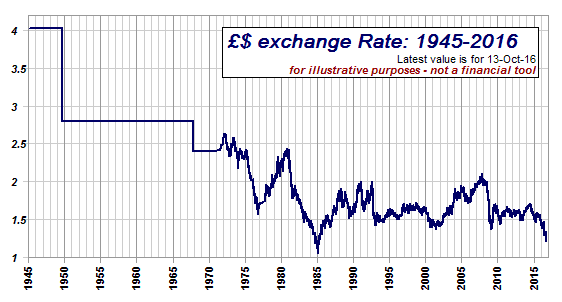Dollar History
1: from
1915
2: from 1940
3: from
1971
4: from
2008
Last update
(excluding graph):
10-Jan-2007
©1996-2009
Mike Todd
![]()
| << Dollar history from 191 |
2: Dollar Exchange Rate from 1940
From 1940, and through the war, although no longer on the Gold Standard, the £/$ rate had been pegged by the British government at $4.03, and in at the end of the war a world conference in Bretton Woods, New Hampshire, decided on a variation of the Gold Standard.
Britain adopted this new system in December, 1945, maintaining the pound at $4.03 ... at which point the Americans sowed the seeds for one of Britain's biggest financial crises.
 During
the war America had helped Britain by providing a wide variety of war-related
goods with the intention of recovering the cost once the war was over.
Through this "lease-lend" arrangement, the Americans held Britain
in a tight grip. For instance, Britain was not permitted to export any
of the goods that America had provided under the lease-lend arrangement,
nor anything that resembled these goods even if they were British-made.
During
the war America had helped Britain by providing a wide variety of war-related
goods with the intention of recovering the cost once the war was over.
Through this "lease-lend" arrangement, the Americans held Britain
in a tight grip. For instance, Britain was not permitted to export any
of the goods that America had provided under the lease-lend arrangement,
nor anything that resembled these goods even if they were British-made.
As a part of the agreement there was to have been a transition period at the end of the war during which full repayment could be made. However, America changed its mind, terminated the agreement and demanded its money there and then, something that Britain's economy simply could not sustain. Instead, America agreed to sell Britain the goods in what was in effect a loan spread over 50 years (which, having deferred a number of payments, Britain eventually paid of on 31st December, 2006)
But this deal came with strings, one of which was that the "unconvertible" pound, fixed under Bretton Woods, had to be made fully convertible within two years. Reluctantly Britain complied and, on 15th August 1947, exchange rate controls were removed.
This compliance with America's terms created a huge run on Sterling, and Britain's already stretched economy was collapsing before everyone's eyes. The British government had to act swiftly, and exchange rate controls were reinstated in a matter of days with the £/$ stabilised at just over $4, and Britain was back on the system it had adopted at Bretton Woods.
The graph on the left doesn't show this 1947 crisis, as it happened over such a short period.
Things didn't get much better and, after immense pressure on the pound (and after nine months of continual statements that it would not happen), on 18 September 1949 Stafford Cripps devalued the pound by over 30%, giving a rate of $2.80
1967 saw another crisis in the British economy and Harold Wilson announced, in November 1967, that the pound had been devalued by just over 14%, resulting in an exchange rate of $2.40. This was the famous "pound in your pocket" devaluation, where Wilson tried to reassure the country by pointing out that the devaluation would not affect the value of money within Britain.
| << Dollar history from 1915 |